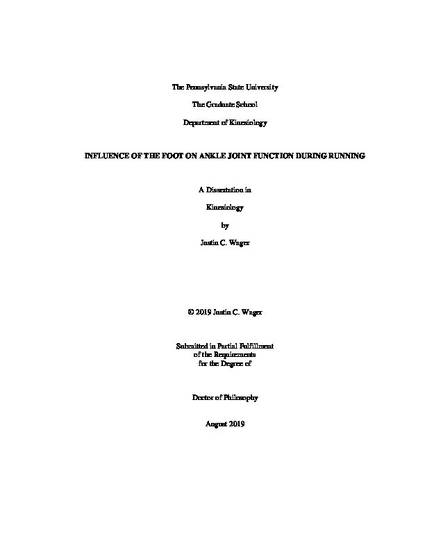
Dissertation
Influence of the Foot on Ankle Joint Function during Running
(2019)
Abstract
The human foot is a complex structure comprising bones and soft tissues which collectively exhibit substantial mobility. However, biomechanical analyses typically model the foot as a single rigid segment, which omits this mobility and its potential effects on surrounding muscles and joints. Recent studies have utilized multisegment foot models, which represent the foot using a system of linked rigid segments. Utilizing these models to analyze walking has shown that ankle joint kinematics and power during push-off differ from those found with traditional single segment foot models. However, multisegment foot models have yet to be used to study ankle joint function during running. In addition, omitting foot mobility from biomechanical models prohibits the study of the interactions between the mobility of the foot and the adjacent joints and tissues. These interactions may arise due to muscles and soft tissues that span both the joints of the foot and the ankle, but there is little work investigating whether these interactions are important to locomotion mechanics. The purpose of the three studies in this dissertation were to 1) compare ankle joint kinematics and kinetics computed using a multisegment foot model and a single segment foot model, 2) determine if foot model topology affects models of the ankle plantarflexor muscles by comparing results of simulations using the multisegment and single segment foot models, and 3) explore the interactions between the metatarsophalangeal and ankle plantarflexor muscles to better understand how foot mobility can influence locomotion mechanics. In Study 1, a multisegment foot model and a single segment foot model were used to compute ankle joint kinematics and kinetics of seven subjects during running. Similar to previous studies on walking, the multisegment foot model produced lower ankle joint excursion over the stance phase and reduced angular velocity and joint power during push-off. In Study 2, the kinematics and kinetics of the two foot models were used to drive simulations of two Hill-type muscle models representing the gastrocnemius and soleus. The reduced ankle joint motion of the multisegment foot model led to decreases in the active state of the two muscles. Combined, Study 1 and Study 2 illustrate that foot model topology plays an important role in the study of ankle joint function during running, affecting both rigid body analyses and muscle simulations. Study 3 sought to understand the effect of the MTP joint position on the moment-generating capacities of the ankle plantarflexor muscles. Eight subjects generated maximum isometric ankle plantarflexions with the MTP joint held in two positions: neutral and maximally dorsiflexed. These two positions potentially changed the length of the extrinsic toe flexor muscles and the length of the plantar aponeurosis, which may alter the length of the triceps surae MTU. No statistically or functionally significant effect of the MTP joint position on the maximum isometric ankle moment was found. This suggests that the connections between the MTP joint and the Achilles tendon do not influence the moment-generating capacities of the ankle plantarflexors and instead may serve other functions during locomotion. Together, the three studies of the dissertation illustrate the importance of capturing the motion of the foot in kinematic and kinetic analyses of the lower limb and its musculature, but suggest that ankle plantarflexor strength is not influenced by the connections between the foot and the ankle. Future work should focus on further understanding the interactions between the foot and ankle by utilizing multisegment foot models to investigate tasks with various mechanical demands.
Keywords
- Running,
- Foot,
- Anke,
- Biomechanics
Disciplines
Publication Date
August, 2019
Degree
Ph.D. Kinesiology
Advisors
John Henry Challis, Dissertation Advisor/Co-Advisor
Comments
Link to dissertation on the Penn State University Library site https://etda.libraries.psu.edu/catalog/16191jcw296
Citation Information
Justin C. Wager. "Influence of the Foot on Ankle Joint Function during Running" (2019) Available at: http://works.bepress.com/justin-wager/5/
Creative Commons license

This work is licensed under a Creative Commons CC_BY-NC-ND International License.
